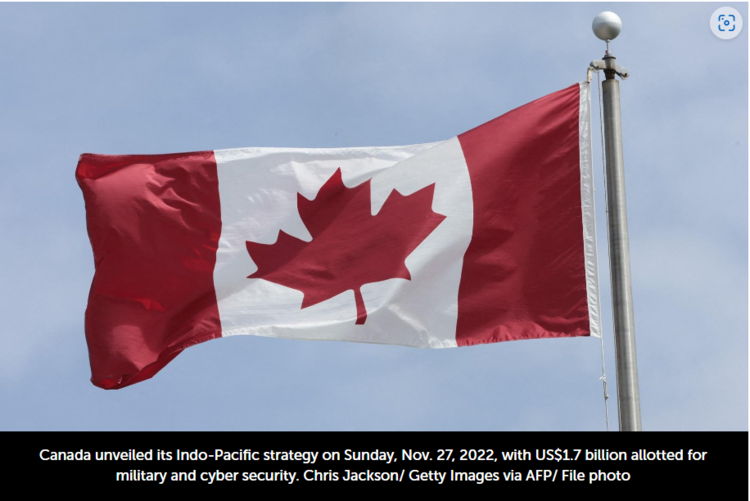
Newsnomics AJAY ANGELINA reporter | Canada launched its long-awaited Indo-Pacific strategy on Sunday
Nov.27, outlining C$2.3 billion ($1.7 billion) ambitious plan for next five years in spending to boost military and cyber security in the region and vowed to focus on a "disruptive" China while working with it on climate
change and trade issues.
As a Pacific nation, Canada recognizes that the Indo-Pacific region will play a significant and profound role in
Canada’s future including national security, economic prosperity, respect for international law and human
rights, democratic values, public health, protecting the environment—will be shaped by the relationships that
Canada, along with its partners, have with countries throughout the Indo-Pacific.
Melanie Joly, Minister of Foreign Affairs said, “The future of the Indo-Pacific is our future; we have a role to
play in shaping it. To do so, we need to be a true, reliable partner. Today, we are putting forward a truly
Canadian strategy—one that involves every facet of our society. It sends a clear message to the region that
Canada is here, and they can trust we are here to stay.”
Canada’s Indo-Pacific Strategy includes 5 interconnected strategic objectives:
1. Promoting peace, resilience, and security
To advance Canada’s regional peace and security interests, the Government will invest over $720 million. This
includes, but is not limited to:
• $492.9 million to reinforce Canada’s Indo-Pacific naval presence and increase Canadian Armed Forces
participation in regional military exercises.
• $47.3 million to launch a new multi-department initiative to help develop cyber security capacity in select
regional partners.
2. Expanding trade, investment, and supply-chain resilience
To foster open, rules-based trade and support Canada’s economic prosperity, Canada will invest $240.6 million. This includes, but is not limited to:
• $24.1 million to establish the Canadian Trade Gateway in Southeast Asia to expand Canada’s business,
investment and networks in the region.
• $31.8 million to establish Canada’s first agriculture office in the region to increase and diversify agriculture and agri-food exports to the Indo-Pacific.
• $13.5 million to expand natural resource ties with Indo-Pacific partners – in trade, investment, and science, technology and innovation.
3. Investing in and connecting people
To forge stronger people-to-people ties with the Indo-Pacific, Canada will contribute $261.7 million. This
includes, but is not limited to:
• $100 million in Feminist International Assistance Policy development funding to support the Indo-Pacific.
• $74.6 million to enhance Canada’s visa processing capacity within Canada’s centralized network as well as
in New Delhi, Chandigarh, Islamabad, and Manila to support stronger peoples-to-people ties.
4. Building a sustainable and green future
As part of its commitment to build a clean future, Canada has committed a total of $913.3 million. This
includes, but is not limited to:
• $750 million to enhance the capacity of FinDev Canada to expand its operations into the Indo-Pacific and accelerate its work in priority markets in order to support high-quality, sustainable infrastructure.
• $84.3 million to help reinforce a healthy marine environment in the Indo-Pacific region including enhanced measures against illegal, unreported, and unregulated (IUU) fishing.
5. Canada as an active and engaged partner in the Indo-Pacific
To strengthen its presence, visibility and influence in the region, Canada has committed a total of $143.3
million. This includes, but is not limited to:
• $92.5 million to significantly expand capacity at Canada’s missions abroad and within Global Affairs
Canada.
• $24.5 million for a new office of the Asia-Pacific Foundation of Canada in the region to help build and
strengthen relations with local partners.
Canada not only is seeking to deepen ties with a fast-growing Indo-Pacific region of 40 countries accounting
for almost C$50 trillion in economic activity. But the focus is on China, which is mentioned more than 50 times, at a moment when bilateral ties are frosty.
"We will engage in diplomacy because we think diplomacy is a strength, at the same time we'll be firm and
that's why we have now a very transparent plan to engage with China," Foreign Minister Melanie Joly said.
The plan detailed in 26-page document underscored Canada's dilemma in forging ties with China, offers
significant opportunities for Canadian exporters, even as Beijing looks to shape the international order into
a more "permissive environment for interests and values that increasingly depart from ours," Melanie Joly
added.
Yet, the document said cooperation with the world's second-biggest economy was necessary to address
some of the "world's existential pressures," including climate change, global health and nuclear proliferation.
"China is an increasingly disruptive global power," said the strategy. "Our approach ... is shaped by a realistic and clear-eyed assessment of today's China. In areas of profound disagreement, we will challenge China."
Moreover, the document, in a section mentioning China, said Ottawa would review and update legislation
enabling it to act "decisively when investments from state-owned enterprises and other foreign entities
threaten our national security, including our critical minerals supply chains."
"Because the region is both large and diverse, one size definitely does not fit all," Canadian Chamber of
Commerce President Perrin Beatty said in a statement, adding that Canada’s priorities will need to be very
nuanced both between and within countries.
Tensions with China soared in late 2018 after Canadian police detained a Huawei Technologies executive and Beijing subsequently arrested two Canadians on spying charges. All three were released last year, but relations remain sour. Canada earlier this month ordered three Chinese companies to divest their investments in Canadian critical minerals, citing national security.










